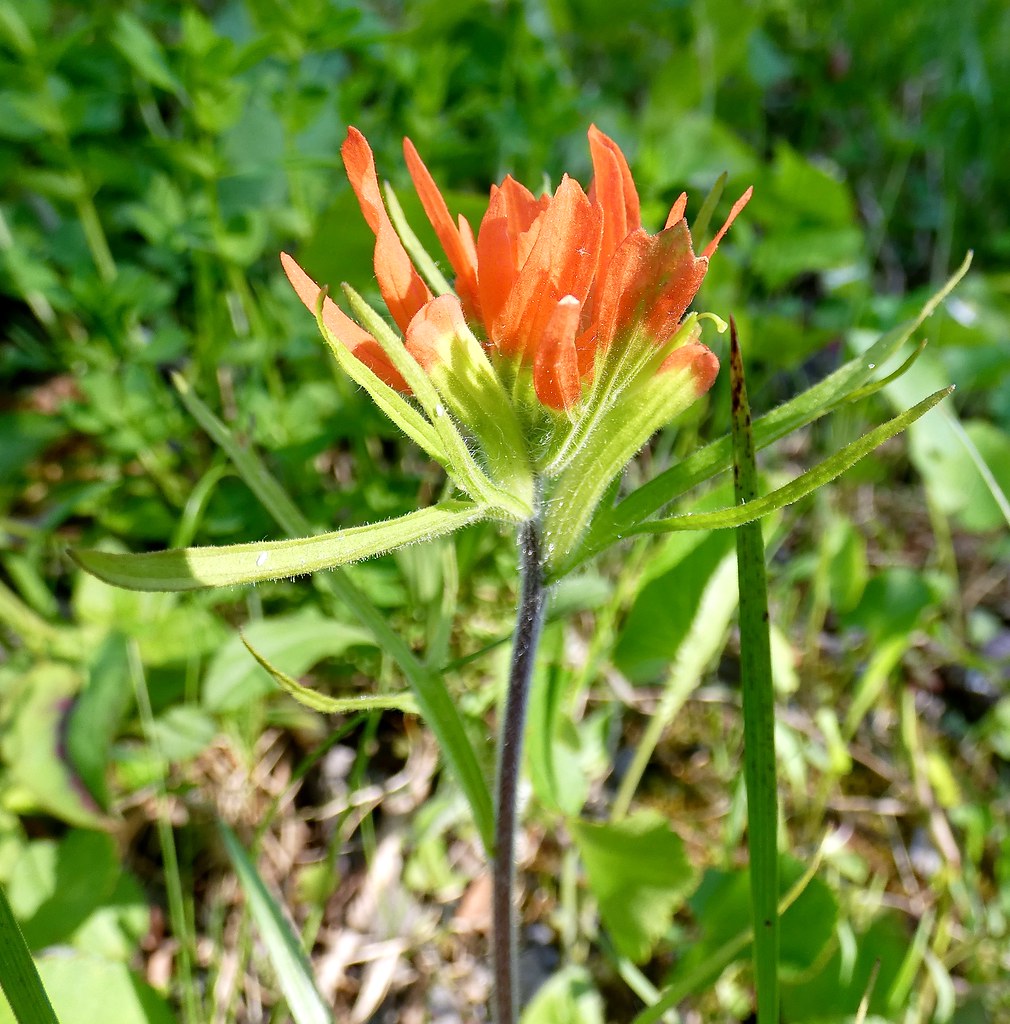Map Snapshot






32 Records
Status
Maryland has only one known population (Garrett County) remaining of this striking native wildflower. All other populations are considered extirpated.
Relationships
Scarlet Indian Paintbrush is hemiparasitic on a variety of other plant species. Ruby-throated Hummingbirds are one of the main pollinators.
Seasonality Snapshot
Source: Wikipedia
| Castilleja coccinea | |
|---|---|

| |
| Castilleja coccinea | |
| Scientific classification | |
| Kingdom: | Plantae |
| Clade: | Tracheophytes |
| Clade: | Angiosperms |
| Clade: | Eudicots |
| Clade: | Asterids |
| Order: | Lamiales |
| Family: | Orobanchaceae |
| Genus: | Castilleja |
| Species: | C. coccinea
|
| Binomial name | |
| Castilleja coccinea | |
Castilleja coccinea, commonly known as scarlet Indian paintbrush[1] or scarlet painted-cup,[2] is a biennial flowering plant in the Orobanchaceae (broomrape) family. It is usually found in prairies, rocky glades, moist and open woodlands, thickets, and along streams in central and eastern North America.
Description
[edit]It is an upright, hairy, 1-to-7-decimeter (3.9 to 27.6 in) tall hemiparasitic plant. In its first year, the plant appears as a basal rosette, and in the second year the stem, usually unbranched, rises from the rosette. The basal leaves are oblong and mostly entire, and usually die before the flowers appear. The alternate stem leaves are deeply and irregularly lobed and measure up to 8 cm (3 in) long. The common names for this plant reflect the showy red bracts, inside of which is the actual greenish-yellow corolla ("flower").[3]
Castilleja coccinea can be distinguished from other Castilleja of the southeastern US because it has a 2-to-3.5-millimeter (0.08 to 0.14 in) long, thin yellowish or orangish lip on the corolla, the inflorescence bracts are deeply lobed, and the basal rosettes of leaves are usually well-developed.[4]
Etymology
[edit]The genus name Castilleja is from the 18th-century Spanish botanist, Domingo Castillejo. The specific epithet coccinea is Latin for 'red'.[5]
Distribution and habitat
[edit]C. coccinea is native throughout the central and eastern United States, from Oklahoma to the west, Florida to the south, Maine to the east, and the Canadian border to the north. It is listed as endangered in New York,[6] Connecticut,[7] and Maryland,[8] It is critically imperiled in New Jersey, West Virginia, Kentucky, Georgia, Alabama, and Mississippi, presumed extirpated in Maine and new Hampshire, and possibly extirpated in Louisiana, Massachusetts, and Rhode Island.[1] It is native in Canada in Saskatchewan, Manitoba, and Ontario, although it is critically imperiled in Saskatchewan.[9]
It is found in prairies, rocky glades, moist and open woodlands, thickets, and along streams.[10]

Ecology
[edit]C. coccinea have color polymorphism, which means that they can be yellow or scarlet in color, and this depends on the availability of pollinators such as bees. When pollinators are present, the scarlet C. coccinea tend to have a higher reproductive output, as they have higher seed and fruit set. On the other hand, the yellow C.coccinea would have a higher reproductive output when pollinators are scarce.[11]
Though it can survive on its own, studies indicate a forty-fold growth increase when its roots parasitize those of another plant for nutrients.[12] It is primarily pollinated by ruby-throated hummingbirds who can transfer the pollen long distances between typically small and scattered populations of this plant.
References
[edit]- ^ a b "NatureServe Explorer 2.0". explorer.natureserve.org.
- ^ "Castilleja coccinea (scarlet painted-cup): Go Botany". gobotany.nativeplanttrust.org.
- ^ "Castilleja coccinea (Indian Paintbrush): Minnesota Wildflowers". www.minnesotawildflowers.info.
- ^ Weakley, Alan (2011). Flora of the Southern and Mid-Atlantic States (Working draft ed.). Chapel Hill, NC (University of North Carolina): Not yet published. p. 843.
- ^ Denison, Edgar (2017). Missouri Wildflowers (Sixth ed.). Conservation Commission of the State of Missouri. p. 112. ISBN 978-1-887247-59-7.
- ^ "Botany Program - NY Natural Heritage Program". www.nynhp.org.
- ^ "Endangered Threatened and Special Concern Plants". CT.gov - Connecticut's Official State Website.
- ^ "Rare, Threatened, and Endangered Plants". Maryland Department of Natural Resources.
- ^ "Reports - Wild Species: The General Status of Species in Canada". www.wildspecies.ca.
- ^ "Castilleja coccinea - Plant Finder". www.missouribotanicalgarden.org.
- ^ Kim, E. S., D. N. Zaya, J. B. Fant, and M. V. Ashley. "Reproductive trade-offs maintain bract color polymorphism in Scarlet Indian paintbrush (Castilleja coccinea)". PLoS ONE 14: e0209176. doi:10.1371.
- ^ Spira, Timothy P. (2011). Wildflowers & plant communities of the southern Appalachian Mountains & Piedmont: a naturalist's guide to the Carolinas, Virginia, Tennessee, & Georgia. Chapel Hill: University of North Carolina Press. p. 345. ISBN 9780807871720.
External links
[edit] Media related to Castilleja coccinea at Wikimedia Commons
Media related to Castilleja coccinea at Wikimedia Commons


